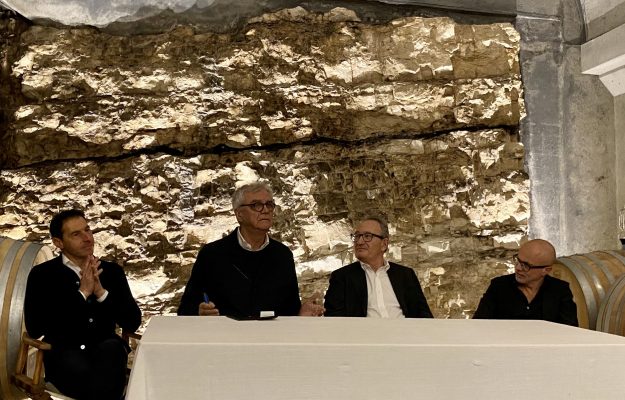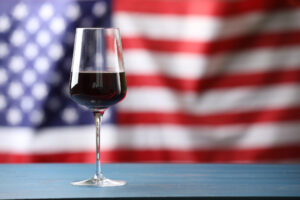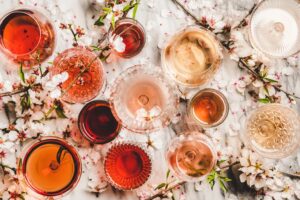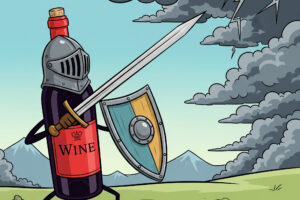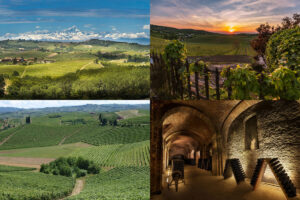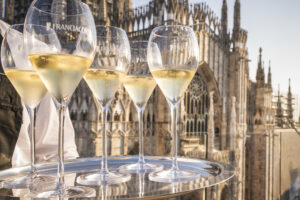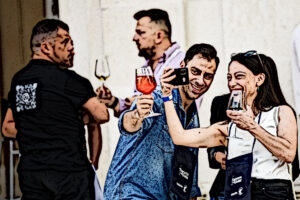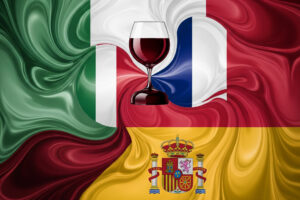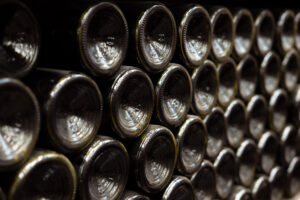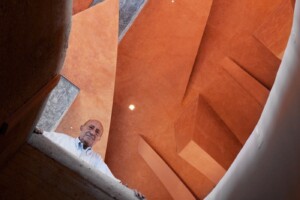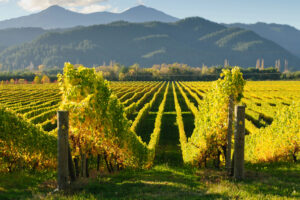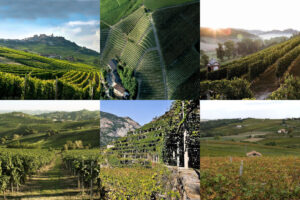“Every company conveys its thoughts on quality, which is mainly the search for a “star” wine; that is, a wine they have put their whole heart and soul into producing. And, here, however, is where two worlds collide. TGI creativity and innovation against the rules and regulations of the DOC”, said Davide Gaeta, Professor of Economics at the University of Verona (and administrator of the Valpolicella Eleva winery, with the oenologist, Raffaella Veroli). His words stimulated a discussion, in his winery, on the innovative value of wines that goes “beyond the rules” of Denominations, with Maurizio Ugliano, Professor of Oenology at the University of Verona, and two “purist” DOC producers, Marco Sartori of Roccolo Grassi, a Valpolicella wine, and Mattia Vezzola, producer and enologist of Costaripa, a symbolic winery in the Valtènesi. The theme is quite relevant in all its aspects (including considering the pertinence or not of “tasting commissions”, launched some time ago by Slow Wine, ed.), and reflected the vision of the producer. “I was, after all, a purist” Gaeta underlined, “before I produced the new TGI Veneto wine that we have called “Cercastelle”(looking for a star). The wine, far from wanting to project Eleva out of the Valpolicella denominations, actually enhances the blend of a local vine (Oseleta) and an International one (Merlot), which Franca Maculan, founder of the company (bequest donated to a charity, ed.), had planted on the 28 terraces that stand on the 6 hectares merged to the company. “Considering that 60% of the world’s wine is produced in non-EU countries that do not use appellations, or anyway use them in differently”, Gaeta continued, “it is legitimate to ask whether DOC and TGI can coexist on the same territory or whether it is necessary to “revise” their relationship”. “Ever since I started in 1996”, Marco Sartori of the Mezzane di Sotto company, said, “I have chosen to work in the DOC area. The success of Valpolicella wines, especially Amarone, has helped me to emerge. I have experimented to improve quality — for instance, by allocating different vineyards to Valpolicella and Amarone, to grow the company and the territory at the same time. The creation of the Super Tuscans and that some leading producers left the Consortia to be able to express themselves in a new way, had struck me deeply and sparked the desire to produce a TGI”.
Regarding the Super Tuscan phenomenon, which had the immense merit of bringing Italian wines to International prominence, Davide Gaeta, Professor of Economics at the University of Verona (and administrator of the Valpolicella Eleva winery, with the oenologist, Raffaella Veroli), recounted how the “exodus” of leading companies from the DOC, such as Fontodi and Pergole Torte, was resolved in Chianti Classico, because he was a consultant for the Black Rooster Consortium at the time. “Readjusting the quality pyramid by introducing a new category at the top - the Gran Selezione - and including stricter production criteria, has brought some producers back to the DOC. The solution did not receive favorable reception”, Gaeta commented, “but the facts proved it was the right choice. The Denominations regulations fix cultivation rules in detail, only to decide to overturn them overnight whenever you want. This does suggest, though, that they can be made more flexible and inclusive”.
In many areas, elasticity is felt to be much needed, but not to the point of “including” wines that have been created with a different philosophy, at the basis of their own TGI classification. “I continued on the DOC path”, Marco Sartori of the Valpolicella brand, Roccolo Grassi, continued, “because I believe in protection Consortiums as bodies of mediation amongst the various players’ positions in the area, which, sometimes, have conflicting interests. And, I also believe in the function of the DOC giving strong identities to wines”, as identities measure the “greatness” of a wine.
“Great wine must have three characteristics”, Mattia Vezzola of the Moniga del Garda Estate, said, describing a conversation with Denise Dubourdieu, who was one of the world’s top oenologists. “It must cost a lot for 200 years, proof that the whole world considers it great. It must come from vines passed from father to son for three generations, who have improved them with at least three cycles of genetic selection. Finally, a great wine must be able to maintain its identity over the years”.
These conditions combined, together with many others, produce a great wine. But, if these were the only ones, in Italy we wouldn't have many great wines, or at least, there would be a lot fewer than what we have. There are other roads to follow that take less than 200 years, which can lead to the “star wine".
Suitability of the territory, viticultural management aimed at the vegetation-production balance of the vine, age and “genetic quality” of the plants, together with savoir faire, are the main, indispensable ingredients. “The challenge”, commented the producer and oenologist, Mattia Vezzola, “is to make a wine that is always consistent and to not change it to keep up with changes in taste. This is a prerogative that is often disregarded when historic companies change hands. The wine is still good, but different, and the price is the same. Within the context of a DOC, if you want to transfer the value of your work to the consumer, you have to play by the rules of the game. Good winemaking and improving vine genetics, according to one's oenological objective, are essential. In Champagne and Burgundy, for instance, the same grape vine is grown, Chardonnay, but they have different characteristics that are suited to the two wines”. The grape itself must have characteristics and elements that contribute to creating the "star wine".
“This is the only real starting point”, Maurizio Ugliano emphasized, “otherwise, it is necessary to resort to interventionist winemaking, which is the enemy of excellence. Wine that confirms the expression of a territory, to the collective idea of typicality, needs to be narrated well. Instead, the regulations cite recurring paradoxical organoleptic descriptions, such as “vinous” or “frank”, or not very credible notes are indicated, such as that of cherry, which does not exist in wine because it is one of the least fragrant of fruits. Chablis is associated with minerality, however debatable this descriptor may be. Loire Sauvignons are characterized by their fumé. This is reason why for a denomination to play its role also in the univocal and original story of the wine, everyone, including the scientific community must make a concerted effort. In this way, we could also improve our great viticultural biodiversity, which has no equal”. “However”, the wine producer Marco Sartori (Roccolo Grassi), added, “we don’t have the courage to rejuvenate the regulations. They could have functioned well in the 1960s, at the dawn of the creation of many DOCs. Therefore, we must go back to mass selection, and evaluate the vintages correctly.The great vintage exists, if there are also lesser ones. Our wine history is short. Italian wine has forged ahead and in relatively short time has conquered International markets. In order to achieve this, it has also had to satisfy the tastes of consumers. Amarone, for instance, which leaves high sugar residues and uses vines that make it more pleasant. Today, we should have the wisdom to reappropriate a style that is closer to our identity, which has been made easier for us because consumers have accepted less colorful and opulent wines”. The unanimous call to the need for research, financed and coordinated also by the Protection Consortiums, is increasingly urgent, due to the pressure of climate change, which makes even very widespread varieties inadequate. Furthermore, there needs to be greater civic awareness of belonging to a territory to protect its products and the environment. “Another challenge”, Maurizio Ugliano Enology Professor at the University of Verona, concluded, “is to understand the relationship among the elements that make up the value of a bottle. We must work on more aspects than improving the intrinsic quality and taste of the wine, and insert humanistic aspects beyond DOC and TGI. When quality is explained and tangible, the price is unequivocal”.
Copyright © 2000/2025
Contatti: info@winenews.it
Seguici anche su Twitter: @WineNewsIt
Seguici anche su Facebook: @winenewsit
Questo articolo è tratto dall'archivio di WineNews - Tutti i diritti riservati - Copyright © 2000/2025










